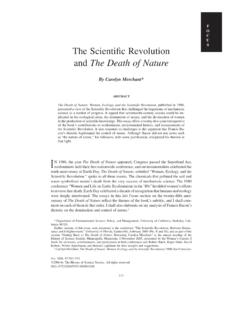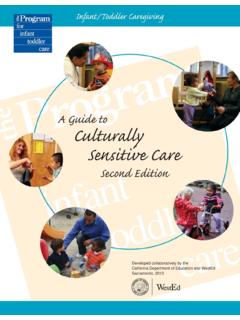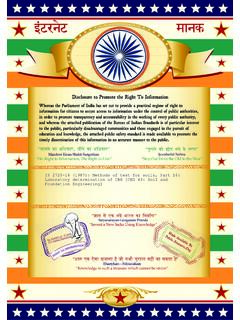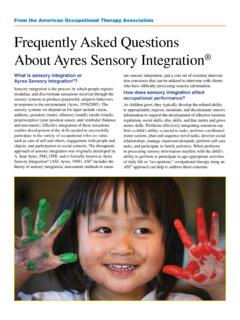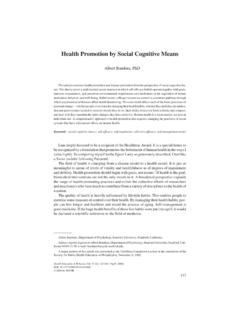Transcription of Introduction to Mathematical Modeling
1 Introduction to Mathematical ModelingDifference Equations, Differential Equations, & Linear Algebra(The First Course of a Two-Semester Sequence)Dr. Eric R. of MathematicsCarroll College, Helena, MTContent Last Updated: January 8, 20181 Eric Sullivan. Some Rights work is licensed under a Creative Commons International License. You may copy, distribute, display, remix, rework, and per-form this copyrighted work, but only if you give credit to Eric Sullivan, and all deriva-tive works based upon it must be published under the Creative Commons Attribution-NonCommercial-Share Alike United States License.
2 Please attribute this work to EricSullivan, Mathematics Faculty at Carroll College, To view a copyof this license, send a letter to Creative Commons, 171 Second Street, Suite 300, San Francisco, Cali-fornia, 94105, To the Student and the An Inquiry Based Approach .. Online Texts and Other Resources .. To the Instructor ..71 Fundamental Notions from Sections from Active Calculus .. Modeling Explorations with Calculus ..102 An Introduction to Linear Why Linear Algebra? .. Matrix Operations and Gaussian Elimination .. Gaussian Elimination: A First Look At Solving Systems.
3 Systems of Linear Equations .. Linear Combinations .. Inverses and Determinants .. Technology For Linear Algebra .. The Magic Carpet Ride .. Span .. Linear Independence, Linear Dependence, and Basis .. The Column and Null Spaces of a Matrix .. Modeling Explorations with Linear Algebra .. Input-Output Economies .. Traffic Networks .. Balancing Chemical Equations ..663 First Order Birth, Death, and Immigration Exploration .. Models for Birth, Death, and Immigration .. Difference Equations and Differential Equations .. Stability and Equilibria.
4 Euler s Method: Numerical Solutions for Differential Equations .. Classifying Difference and Differential Equations .. Technique: Solving 1stOrder Linear Homogeneous Equations .. Technique: Solving 1stOrder Linear Nonhomogeneous Equations .. Technique: Separation of Variables .. Technique: Undetermined Coefficients .. Modeling Explorations with Difference and Differential Equations .. 1024 Second Order Modeling Oscillations .. Homogeneous Linear 2ndOrder Differential Equations .. Forced Oscillations .. Energy in Mass Spring Systems A Lab Exploration.
5 Modeling Explorations with 2ndOrder Differential Equations .. 1295 Systems of Difference and Differential Spread of Disease .. Spreading a Juicy Rumor .. The H1N1 Virus .. Writing Systems of Difference Equations .. Linear Systems .. The Eigenvalue / Eigenvector Problem .. of Eigenvectors and Eigenvalues .. Eigenvalue Eigenvector Problem .. for the Eigenvalue Eigenvector Problem .. Markov Chains .. Analysis of Linear Systems .. Systems of Linear Difference Equations .. of Equilibrium Behavior .. Homogeneous Systems of Linear Difference Equations.
6 Modeling Explorations with Systems .. 1696 Infinite Sections from Active Calculus .. 174 Appendices175A MATLAB Vectors and Matrices .. Looping .. For Loops .. The While Loop .. Conditional Statements .. If Statements .. Case-Switch Statements .. Functions .. Plotting .. Animations .. 183 Chapter 0To the Student and the InstructorThis document contains lecture notes, classroom activities, examples, and challenge prob-lems specifically designed for a first semester of differential equations and linear algebrataught with a focus on Mathematical Modeling .
7 The content herein is written and main-tained by Dr. Eric Sullivan of Carroll College. Problems were either created by Dr. Sul-livan, the Carroll Mathematics Department faculty, part of NSF Project Mathquest, partof the Active Calculus text, or come from other sources and are either cited directly orcited in the LATEX source code for the document (and are hence purposefully invisible tothe student). Inquiry Based ApproachProblem (Setting The Stage). Get in groups of size 3-4. Group members should introduce themselves. For each of the questions that follow I will ask you a possible answer on your answers with the rest of the summary of each group s discussionQuestions:Question #1:What are the goals of a university education?
8 Question #2:How does a person learn something new?Question #3:What do you reasonably expect to remember from your courses in 20 years?Question #4:What is the value of making mistakes in the learning process?Question #5:How do we create a safe environment where risk taking is encouraged andproductive failure is valued?N5 CHAPTER 0. TO THE STUDENT AND THE INSTRUCTOR6(The previous problem is inspired by Dana Ernst s first day activity in IBL activitytitled: Setting the Stage.) Any creative endeavor is built in the ash heap of failure. Michael StarbirdThis material is written with an Inquiry-Based Learning (IBL) flavor.
9 In that sense, thisdocument could be used as a stand-alone set of materials for the course but these notesare not atraditional textbookcontaining all of the expected theorems, proofs, examples,and exposition. The students are encouraged to work through problems and homework,present their findings, and work together when appropriate. You will find that this doc-ument contains collections of problems with only minimal interweaving exposition. It isexpected that you do every one of the problems and then use other more traditional textsas a backup when you are stuck. Let me say that again: this is not the only set of materialfor the course.
10 Your brain, your peers, and the books linked in the next section are yourbest resources when you are learn more about IBL go to Thelong and short of it is that the students in the class are the ones that are doing the work;building models, proving theorems, writing code, working problems, leading discus-sions, and pushing the pace. The instructor acts as a guide who only steps in to redirectconversations or to provide necessary insight. If you are a student using this material youhave the following jobs:1. Fight! You will have to fight hard to work through this material.

